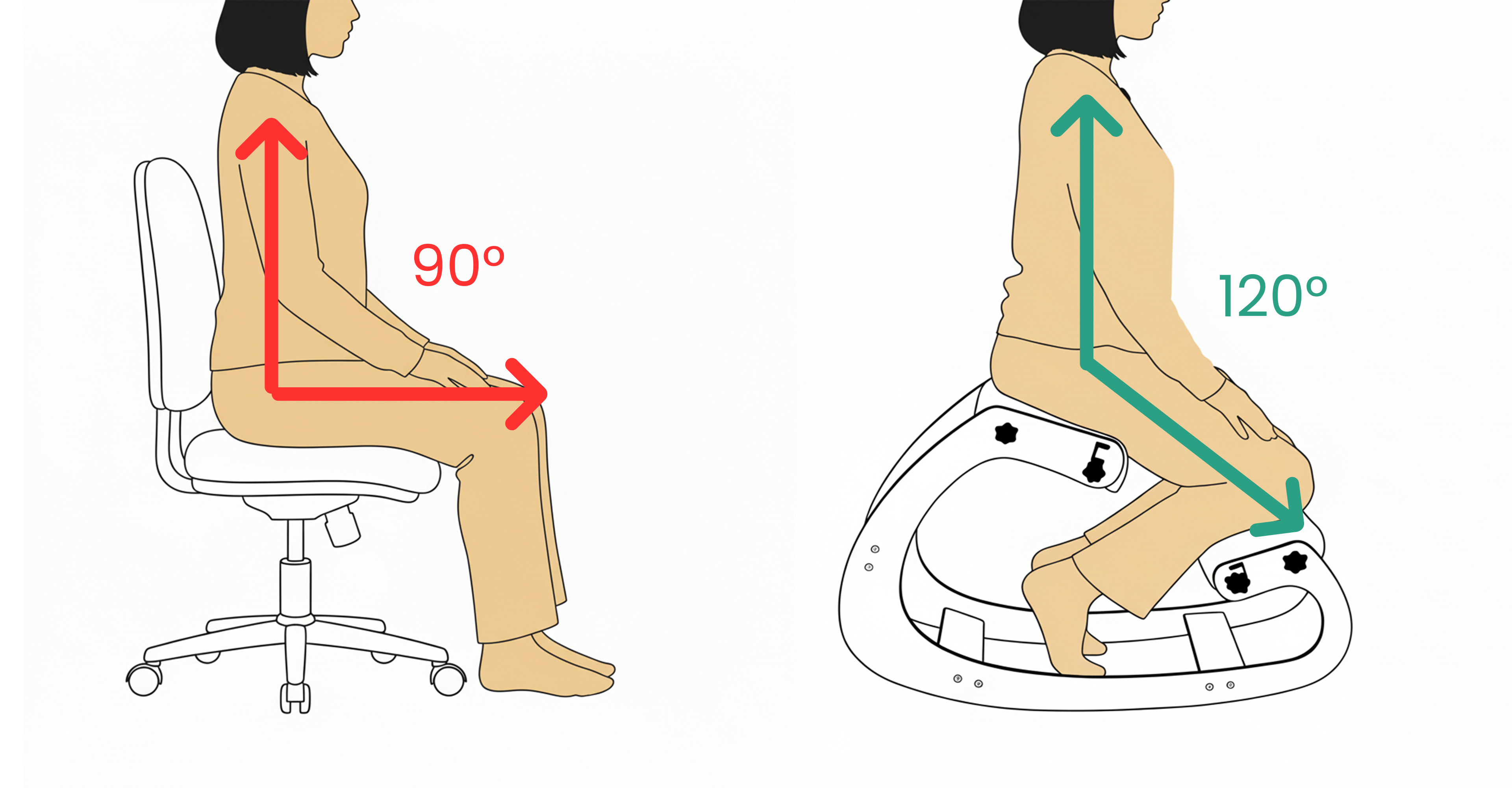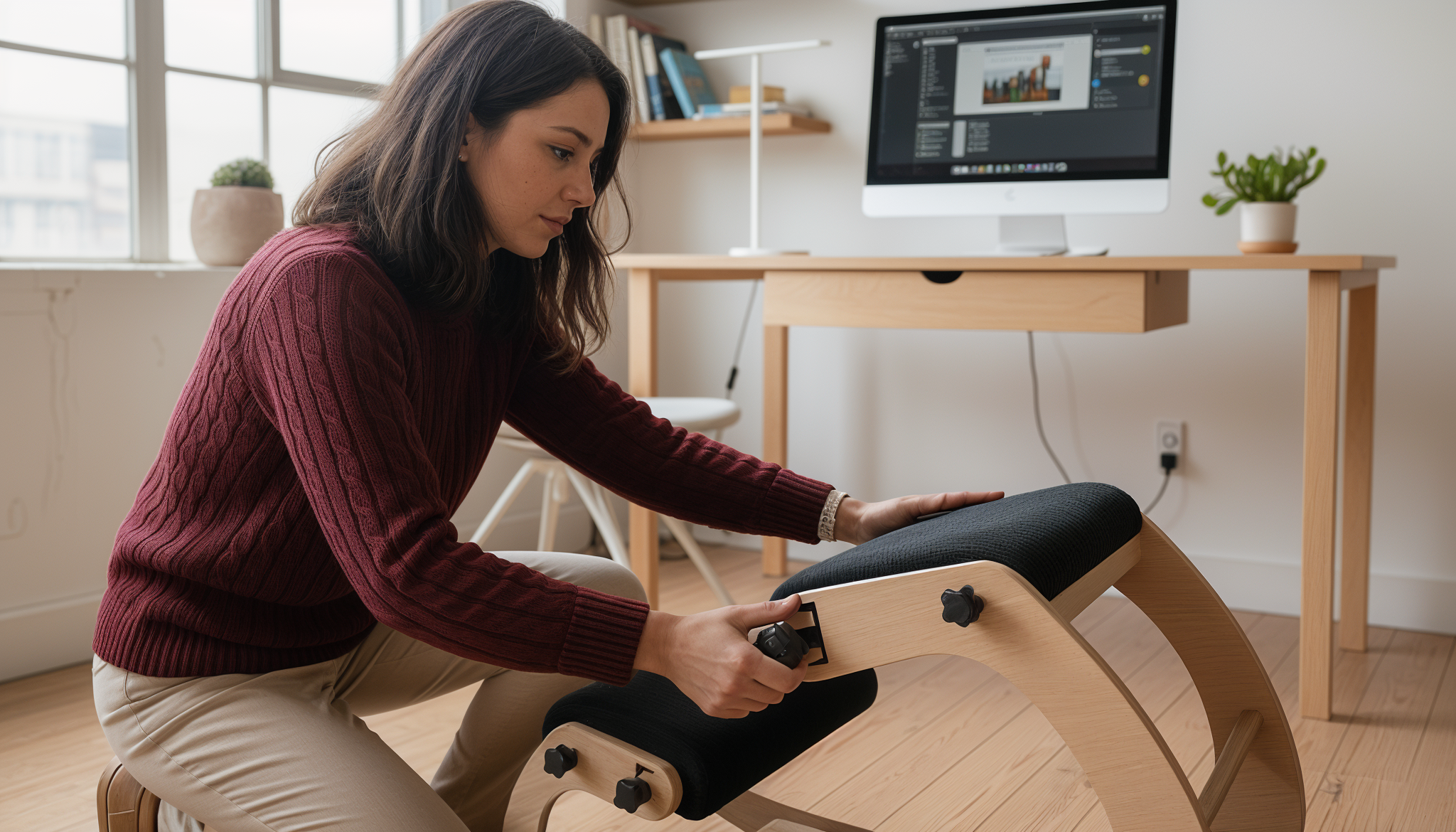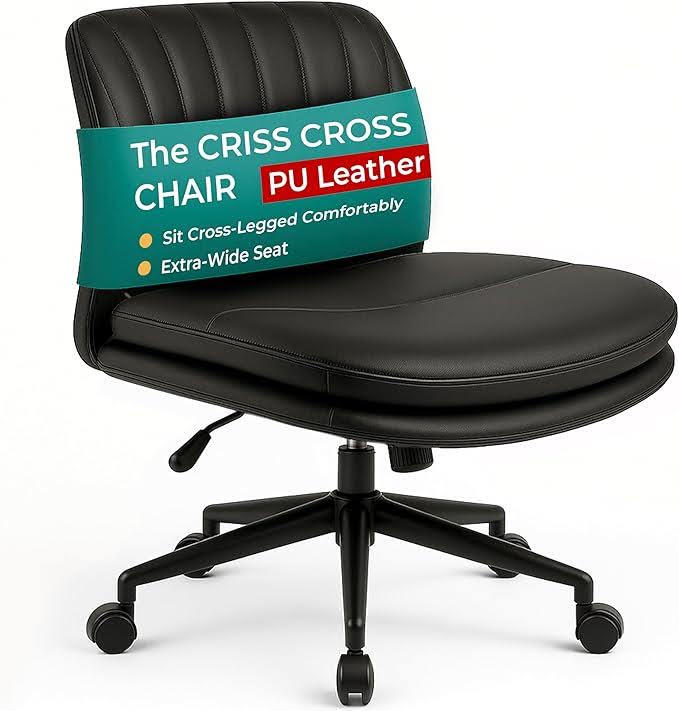Understanding Kneeling Chair Ergonomics: A Science-Based Guide to Active Sitting
Lower back pain affects 80% of desk workers at some point in their careers. Neck stiffness, shoulder tension, and chronic discomfort have become so common that many people assume it’s just “part of having a desk job.”
It doesn’t have to be.
At ErgoLife Foundation, we’ve spent years researching alternative seating solutions that address the root biomechanical causes of desk-related pain. One of the most effective—and often misunderstood—is the kneeling chair.
This isn’t about trendy furniture. It’s about understanding how your body responds to different seating positions and making informed choices about your workspace health.
The Biomechanics Problem with Traditional Chairs
Most office chairs share the same basic design: a seat that positions your hips at 90 degrees with back support.
Here’s what happens to your body in that position:
- Your spine loses its natural curve. When you sit at 90 degrees, your pelvis tilts backward (posterior tilt), flattening your lower back and increasing pressure on lumbar discs by up to 40%.
- Your core muscles disengage. Full back support allows your stabilizing muscles to essentially “turn off,” leading to weakness over time.
- Pressure concentrates on your sit bones and lower spine. Your entire body weight rests on a small surface area, restricting blood flow and compressing tissues.
- You naturally slouch forward. The 90-degree hip angle makes it biomechanically difficult to maintain an upright posture without constant conscious effort.
This isn’t a design flaw in your chair—it’s a fundamental limitation of the traditional seating position.

Hip angle comparison: Traditional chair (90°) vs Kneeling chair (110-120°)
How Kneeling Chairs Work: The Biomechanical Difference
A kneeling chair takes a different approach to supporting your body. Instead of the conventional seat-and-back design, it features:
- A forward-tilted seat pad for your buttocks
- Lower shin pads that distribute part of your weight to your shins
- An open hip angle of 110-120 degrees (instead of 90)
What This Design Does to Your Body:
1. Opens Your Hip Angle
The forward tilt naturally opens your hips to 110-120 degrees. This single change triggers a cascade of postural benefits:
- Your pelvis tilts forward (anterior tilt) instead of backward
- Your lumbar spine restores its natural inward curve (lordosis)
- Pressure on intervertebral discs reduces by 12-18%
- Your upper body naturally aligns over your pelvis
2. Redistributes Your Weight
Instead of your entire weight pressing down on your sit bones and lower spine, it’s distributed across two surfaces:
- Approximately 60-70% on your buttocks
- Approximately 30-40% on your shins
This redistribution means less concentrated pressure on any single area, improving circulation and reducing localized discomfort.
Weight distribution: 60-70% on buttocks, 30-40% on shins
3. Engages Core Muscles
Without a backrest to lean against, your core and back muscles must gently engage to maintain your upright position. This isn’t strenuous—it’s about 5-10% of maximum muscle contraction—but it’s enough to:
- Build postural muscle endurance over time
- Increase body awareness and postural consciousness
- Keep muscles active rather than static
4. Encourages Micro-Movements
The design naturally promotes subtle position shifts—slight weight redistributions, small postural adjustments—that keep your body in motion rather than locked in one position.
The Research Behind Active Sitting
This isn’t just theory—peer-reviewed research supports the biomechanical benefits:
- Grooten et al. (2017) found that active workstations reduced neck-shoulder pain by 48% in desk workers
- O’Sullivan et al. (2012) demonstrated that dynamic seating improved spinal posture variability by 67%
- Kingma & van Dieën (2009) showed that active sitting increased trunk muscle activity 3-4 times compared to traditional chairs
- Ellegast et al. (2012) measured 12-18% reduction in lumbar disc pressure with variable postures
The consistent finding: movement and postural variation matter more than achieving any single “perfect” position.
Who Benefits from Kneeling Chair Ergonomics?
Based on ergonomic research and biomechanical principles, kneeling chairs are particularly effective for people with:
Lower Back Pain from Sitting
If you experience lumbar discomfort that worsens throughout your workday and improves when you stand, a kneeling chair addresses the root cause: excessive lumbar disc pressure from posterior pelvic tilt.
Chronic Slouching Habits
People who naturally slouch in traditional chairs often find that a kneeling chair makes upright posture feel effortless rather than forced. The biomechanics work with your body instead of against it.
Desire for Active Sitting
If you’re already interested in standing desks, balance stools, or other dynamic seating options, kneeling chairs fit perfectly into an active sitting rotation.
Core Weakness
The gentle core engagement builds strength over time, making it valuable for people recovering from injury or looking to improve postural muscle endurance.
Spine alignment: Traditional sitting vs Active sitting with kneeling chair
Who Should Be Cautious?
Kneeling chairs aren’t appropriate for everyone. Based on ergonomic research, we typically don’t recommend them for:
- People with knee or shin injuries/conditions
- Those with circulation issues in their lower legs
- Individuals who need to get up and down frequently (the position takes slightly longer to exit)
- Anyone with severe mobility limitations
There’s also an adjustment period—usually 1-2 weeks—as your body adapts to the new position. Starting with 20-30 minute sessions and gradually increasing duration helps most people adapt comfortably.
What to Look for in a Kneeling Chair
If you’re considering trying a kneeling chair, here’s what matters from an ergonomic perspective:
Adjustability
- Seat height adjustment (critical for proper hip angle)
- Shin pad angle (affects weight distribution)
- Seat tilt (fine-tunes pelvic position)
Padding Quality
Look for firm but comfortable padding on both seat and shin pads. Too soft = inadequate support. Too firm = pressure points.
Stability
The base should feel solid without wobbling. Castors (wheels) allow mobility but ensure they lock when needed.
Weight Distribution
When you sit, approximately 60-70% of your weight should rest on the seat, with 30-40% on the shin pads. If it feels like you’re kneeling rather than sitting, the balance is wrong.
Build Quality
Look for metal frames over plastic, reinforced joints, and weight capacity that exceeds your body weight by at least 50 pounds.
Download Our Complete Guide
Get our free 25-page Complete Ergonomic Workspace Guide with comprehensive assessment checklist and 12 illustrated desk exercises.
Integrating Kneeling Chairs into Your Workspace
Based on ergonomic best practices, here’s the most effective approach:
Start Gradually
Week 1: Use the kneeling chair for 20-30 minutes at a time, alternating with your regular chair.
Week 2-3: Increase to 1-2 hour sessions if comfortable.
Week 4+: Use for longer periods as your body adapts, but continue varying your position throughout the day.
Combine with Position Variation
The healthiest workspace strategy includes multiple positions:
- 50% sitting in kneeling chair
- 25% sitting in traditional chair
- 25% standing or moving
Remember: Your best posture is your next posture. No single position, no matter how ergonomically sound, should be maintained all day.
Pair with Proper Desk Height
Your desk should position your forearms roughly parallel to the floor when seated in the kneeling chair. You may need to adjust your desk height or use a keyboard tray to achieve this.
Beyond the Chair: The Full Ergonomic Picture
A kneeling chair addresses one important piece—seating posture—but complete workspace health requires attention to:
- Monitor height (top at or slightly below eye level)
- Keyboard and mouse position (neutral wrist alignment)
- Lighting (no glare on screen)
- Regular movement breaks (every 30-60 minutes)
- Desk exercises (counteract static postures)
Download Our Complete Ergonomic Workspace Guide
Get our free 25-page Complete Ergonomic Workspace Guide with comprehensive assessment checklist and 12 illustrated desk exercises.
Our Mission at ErgoLife Foundation
We research and evaluate various ergonomic solutions—including kneeling chairs, standing desks, active stools, and traditional seating with modifications—to understand what works for different body types, work styles, and conditions.
Our mission is to provide accessible education and guidance so everyone can make informed decisions about their workspace health, regardless of budget. We believe that desk work shouldn’t cause pain, and that understanding the biomechanics of seating is the first step toward lasting comfort.
Kneeling chairs represent one valuable tool in the ergonomic toolkit. For some people, they’re transformative. For others, a different solution might be more appropriate. Our goal is to help you understand the science so you can make the best choice for your body.
The Science of Comfortable Sitting
Ergonomics isn’t about finding a “magic chair” that solves everything. It’s about understanding how your body responds to different positions, movements, and support systems—then making intentional choices that align with your biomechanics.
Kneeling chairs work because they address fundamental postural mechanics: hip angle, spinal alignment, weight distribution, and muscle engagement. The research supports this. The biomechanics confirm it.
The real question is: How can you use this knowledge to create a healthier, more comfortable workspace for yourself?
That’s a question our free resources can help you answer.
Join Our Community Newsletter
Get monthly ergonomic tips and research insights delivered to your inbox. Latest research, practical tips, success stories, and free resources.
Questions about ergonomic seating? Contact our team at info@ergolifefoundation.org


